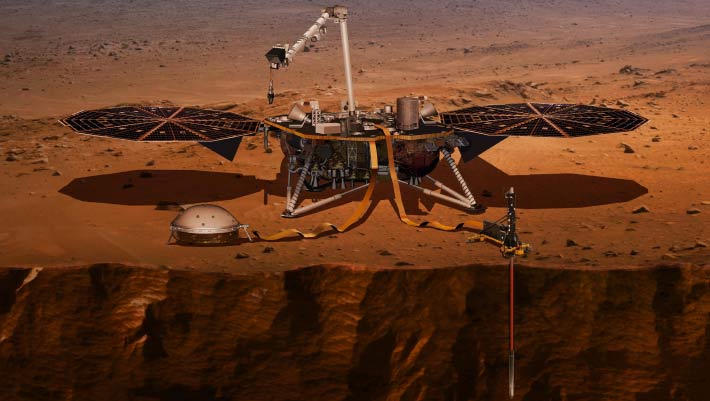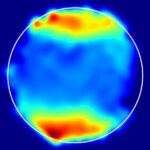To track the Red Planet’s spin rate, planetary scientists relied on the Rotation and Interior Structure Experiment (RISE) onboard NASA’s InSight lander. They found the planet’s rotation is accelerating by about 4 milliarcseconds per year — corresponding to a shortening of the length of the Martian day by a fraction of a millisecond per year.
The RISE instrument on the InSight lander is part of a long tradition of Mars landers using radio waves for science, including the twin Viking landers in the 1970s and the Pathfinder lander in the 1990s.
But none of those missions had the advantage of InSight’s advanced radio technology and upgrades to the antennas within NASA’s Deep Space Network on Earth.
Together, these enhancements provided data about five times more accurate than what was available for the Viking landers.
In the case of InSight, scientists would beam a radio signal to the lander using the Deep Space Network.
RISE would then reflect the signal back.
When scientists received the reflected signal, they would look for tiny changes in frequency caused by the Doppler shift.
Measuring the shift enabled researchers to determine how fast the planet rotates.
“What we’re looking for are variations that are just a few tens of centimeters over the course of a Martian year,” said RISE principal investigator Dr. Sebastien Le Maistre, a researcher at the Royal Observatory of Belgium.
“It takes a very long time and a lot of data to accumulate before we can even see these variations.”
Dr. Le Maistre and colleagues examined data from InSight’s first 900 Martian days — enough time to look for such variations.
They had their work cut out for them to eliminate sources of noise: water slows radio signals, so moisture in the Earth’s atmosphere can distort the signal coming back from Mars.
So can the solar wind, the electrons and protons flung into deep space from the Sun.
“It’s a historic experiment. We have spent a lot of time and energy preparing for the experiment and anticipating these discoveries,” Dr. Le Maistre said.
“But despite this, we were still surprised along the way — and it’s not over, since RISE still has a lot to reveal about Mars.”
The RISE data were also used by the study authors to measure Mars’ wobble — called its nutation — due to sloshing in its liquid core.
The measurement allows the scientists to determine the size of the core: based on RISE data, the core has a radius of roughly 1,835 km (1,140 miles).
They then compared that figure with two previous measurements of the core derived the from spacecraft’s seismometer.
Specifically, they looked at how seismic waves traveled through the planet’s interior — whether they reflected off the core or passed through it unimpeded.
Taking all three measurements into account, they estimate the core’s radius to be between 1,790 and 1,850 km (1,112-1,150 miles).
Mars as a whole has a radius of 3,390 km (2,106 miles) — about half the size of Earth’s. Measuring Mars wobble also provided details about the shape of the core.
“RISE’s data indicate the core’s shape cannot be explained by its rotation alone,” said Dr. Attilio Rivoldini, a researcher at the Royal Observatory of Belgium.
“That shape requires regions of slightly higher or lower density buried deep within the mantle.”
The study was published in the journal Nature.
_____
S. Le Maistre et al. 2023. Spin state and deep interior structure of Mars from InSight radio tracking. Nature 619, 733-737; doi: 10.1038/s41586-023-06150-0




